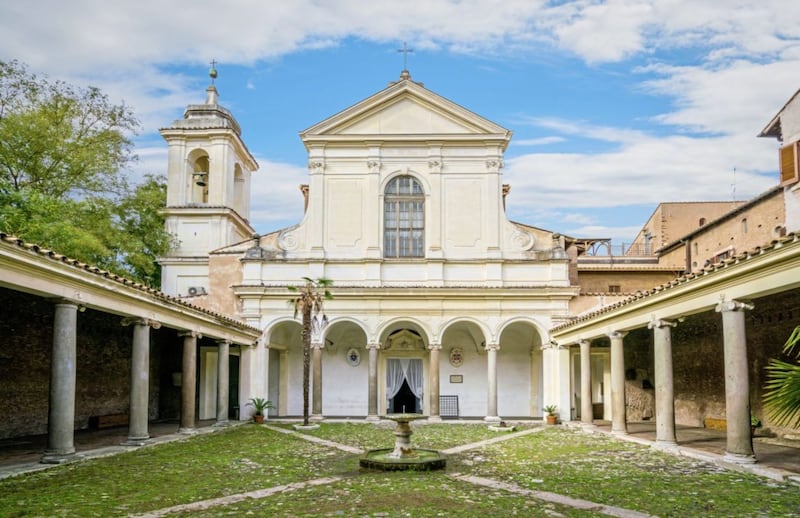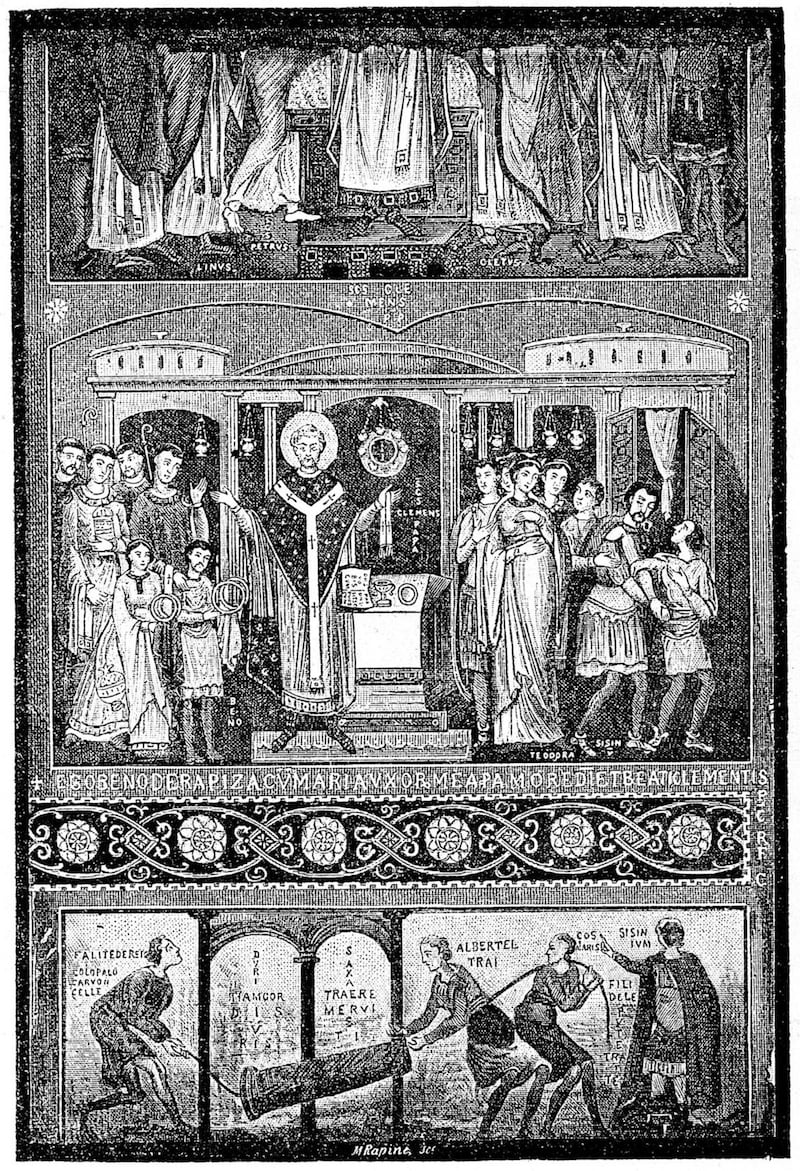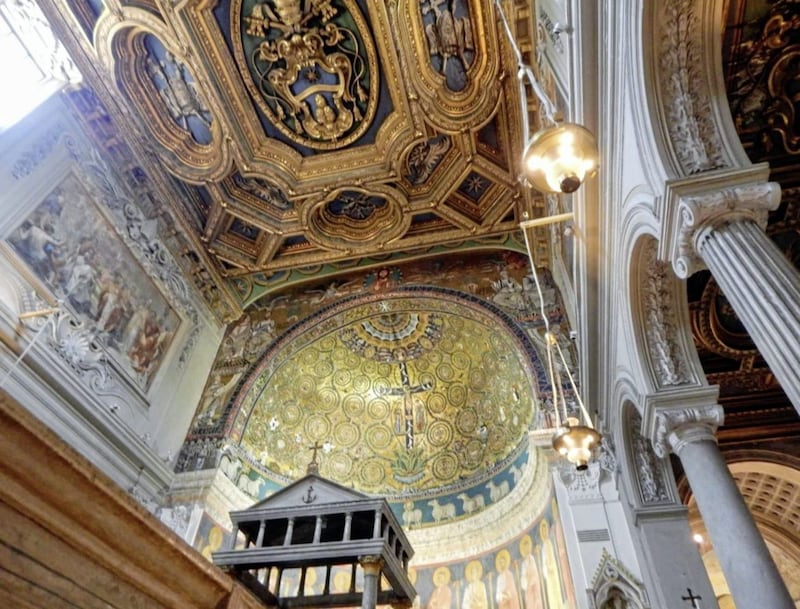THE oldest known reference to the church of Saint Clement in Rome is from the end of the 4th century, around 392, 40 years before Saint Patrick arrived in Ireland.
In a work called On Illustrious Men, Saint Jerome included a short chapter on Clement of Rome which ends by saying "a church built at Rome preserves the memory of his name to this day" (De viris illustribus, c.15).
Clement is mentioned in the first Eucharistic Prayer, 'Peter, Linus, Cletus and Clement' being the first of the bishops of Rome, and one of the earliest Christian documents outside the New Testament is Clement’s Letter to the Corinthians sent about the year 90.
Today, if you come to Rome, you can visit the church of Saint Clement, just a few minutes' walk from the Colosseum.
Until the middle of the 19th century it was believed that this was the building mentioned by Jerome.
Clearly it had been much changed in the meantime - a medieval pavement and mosaic had been added, later a Renaissance chapel, later still a Baroque ceiling - but there were still the walls of the choir, dating from the 6th century, and some other things that were clearly very ancient.
In 1857 however, an excavation by the Dominican prior of the time, Joseph Mullooly of Longford, led to one of the most astonishing discoveries in the history of Christian archaeology.
For under the present church he found an older basilica, the one known to Saint Jerome, which had been filled in at the beginning of the 12th century in order to build a new basilica on top of it.
San Clemente was entrusted to the Irish Dominicans in 1677 and they have been privileged to have the care of it ever since. It is a microcosm of the history of the city, with many beautiful works of art
Why this extraordinary decision was made, we do not know. But it was in this older church that the walls of the 6th century choir were first arranged and it contains many remarkable frescoes dating from the 9th through to the 11th centuries.
Fr Mullooly kept digging and discovered that this older church in its turn had been constructed over buildings dating to the 1st century, contemporary therefore with Peter and Paul, with Nero and the great fire of Rome.
At this level there are two buildings, one an apartment block and the other a warehouse or storehouse of some kind.
In the cortile of the apartment block is a Mithraic temple, a meeting place for devotees of the cult of Mithras, a religion that enjoyed much support across the Roman Empire, particularly among its soldiers.
These lower levels were not underground buildings although they seem like that today.
What happened was that ground level rose significantly over the centuries. The church is located in what was originally a very steep ravine between two of Rome’s ancient hills. Gradually that ravine was filled in and ground level rose accordingly.

So, three levels can be seen today. Between them they contain a collection of artistic and architectural treasures second to none in the Eternal City.
There is something from practically every century between the 1st and the 21st centuries, some of them works of exceptional beauty that have inspired admiration, faith and devotion across the centuries.
Among these works of art, the most famous is a mosaic in the apse of the present church which represents the cross of Jesus as the tree of life.
As his body is drained of all life, that life goes down into a tree which sprouts from the foot of the cross and sends its branches to cover the entire surface of the apse.
Within those branches are details representing all of human life and all of creation, for nothing and nobody falls outside the reach of Jesus' redeeming work.
So, there are women feeding chickens and men tending sheep and goats, there are scholars and administrators and clerics, there are beings of the higher, angelic worlds, reaching up towards the heavenly realm which just touches the top of the cross.
There you can see the hand of the Heavenly Father, carrying a laurel wreath, the sign of victory for an athlete in the ancient world.
Through his passion and death, Jesus was victorious in his engagement with sin, with evil and with death itself, and the Father's hand is reaching down to reward him.
The mosaic continues out onto what is called the façade of the apse, where we find Isaiah and Jeremiah, Peter and Paul, the Roman saints Lawrence and Clement, and above them Christ with the symbols of the four evangelists.
The Renaissance chapel of Saint Catherine of Alexandria is decorated with frescoes done by Masolino da Panicale (1383-1447). He was an Italian artist of the early Renaissance, important not just for his own work but for his influence on Masaccio and through him on all the great artists of the High Renaissance.

In present-day San Clemente, therefore, you can look in one direction to admire the medieval style of the mosaic, still showing signs of the Byzantine artistic tradition by which its creators were influenced, and then look in the other direction to admire the emerging humanistic style of the Renaissance.
In the lower basilica is a series of frescoes representing scenes from the life of Saint Clement and Saint Alexis (another Roman saint), as well as a fresco showing the return of Saint Clement's relics to Rome.
This was a key moment in the history of the church of Saint Clement. He had been martyred in the east, thrown into the Black Sea with an anchor round his neck.
In fact, more of his relics are venerated today in an Orthodox monastery in Kiev, Ukraine.
But in 869 the saintly brothers Cyril and Methodius, patron saints of the Slavic peoples, arrived in Rome to see the Pope, bringing with them some of the relics of Clement.
These were joyfully placed in the church which, as noted above, had been in existence already for many centuries.
Sadly, Cyril died in Rome shortly after this celebration and was himself buried in the church of Saint Clement.
It is why the church is an important pilgrimage destination for Slavs visiting Rome. They seek out the site of his original tomb in the lower basilica and venerate his relics which are kept in the present church, in a special chapel built for them by Pope Leo XIII.
Another very interesting fresco at the middle level represents the descent into hell, or the harrowing of hell, as Jesus visits the abode of the dead and leads out those now redeemed by his work, beginning with Adam and Eve.
Dating from about the 10th century it is believed to be the oldest representation in the western church of this moment of the paschal mystery.
In the Eastern Church the harrowing of hell is the usual way of representing the resurrection of Jesus, showing him breaking down the doors of hell to bring freedom and eternal life to those imprisoned there.

San Clemente was entrusted to the Irish Dominicans in 1677 and they have been privileged to have the care of it ever since.
It is a microcosm of the history of the city, with many beautiful works of art. It holds relics of Saint Clement and Saint Cyril.
Under the high altar also, tradition says, are relics of Saint Ignatius of Antioch who was martyred in the Colosseum, his remains being moved then to the nearby church of Saint Clement.
At present there is a community of 12 Dominican friars living at San Clemente, mostly Irish, and mostly teachers and students at the Roman universities.
There is also an active spiritual and pastoral life, with a small but devoted congregation from the neighbourhood.
The feast of Saint Clement, November 23, is marked not only with a solemn Mass but with a festival involving stalls and entertainments of various kinds on the streets around the basilica. It is a port of call for many pilgrims and other visitors from Ireland.
If, as some traditions maintain, Saint Patrick visited Rome before returning to Ireland as a bishop, he may have visited the church of Saint Clement.
Saint Jerome wrote about it just 40 years before. That Patrick might have made such a visit is just a pious legend and we have no evidence to confirm it.
But, as the Romans say, "Se non è vero, è ben trovato" ('If it is not true, then it ought to be').
Irish Dominican and celebrated theologian Fr Vivian Boland OP is emeritus director of the Aquinas Institute at Oxford University and is based at San Clemente in Rome. The Basilica is among the city's most important historical sites, and is renowned for its spectacular mosaics and frescoes, 4th century basilica and 1st century pagan temple.
More at qubcatholic.org, the blog of the Catholic Chaplaincy at Queen's University Belfast. Other articles include Professor Kevin G. Grove, CSC, an assistant professor of systematic theology at the University of Notre Dame, on
[ Works of the Resurrection: Typologies for Catholic EducationOpens in new window ]
.



